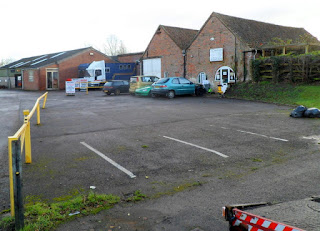The
medieval Cambridge mill in Gloucestershire
Niall
C.E.J. O’Brien
The mill at Cambridge, on the River Cam, in the
manor of Slimbridge in Gloucestershire, was much like a medieval mill in any
other part of medieval England. A mill was an important source of revenue and
most, though not all, manors had a mill. The tenants of the manor had to bring
their grain to the manorial mill and the miller took part of the grain as his
fee. As such the miller was one of the most important lay residents of a manor but not always the most popular. Manorial court records often mention complaints against the miller for the inexactness of his measures and the dishonesty of his fees.
Cambridge location map in Gloucestershire
Cambridge is today a
small hamlet about 3 miles from Dursley and about 11 miles from Gloucester and
lies in the parish of Slimbridge. The medieval manor of Slimbridge, which
included Cambridge, Gossington and Kingston, was granted to Maurice de Berkeley
Fitz Harding by Roger de Berkeley of Dursley before 1190 on the marriage of
Maurice and Roger’s daughter.[1] In
1281 Maurice de Berkeley, lord of Berkeley, held Slimbridge from Henry de
Berkeley of Dursley by some unknown service as it was given in free marriage.
The manor was then worth £20 per year.[2]
Although no specific
references to the medieval mill at Cambridge appear to have survived,
associated references do exist. In the time of King Edward the First, Thomas de
Berkeley (d. 1321), lord of Berkeley, leased the house beside Cambridge mill,
which was formerly held by Edith de Cambridge, to William Flerding for the
lives of William, his first wife and their issue at a rent of 5s per year. This
leased was witnessed by Robert de Bradeston, Thomas de Beoleye, Elias le
Botiler, Richard le Due and John Halling; possibly all local people of the
Cambridge area.[3]
River Cam in Gloucestershire
On 22nd July
1310 Thomas de Berkeley, lord of Berkeley, granted to William Flerdyng and
Margaret his wife, the messuage, garden, curtilage and croft formerly held by
Edith de Cambridge beside the mill. But Thomas de Berkeley reserved sufficient
land to improve the millpond at Cambridge. William and Margaret Flerdyng also
received pasture rights for forty sheep and one cow. This grant was for the
lives of William, Margaret and their son, Peter, at an annual rent of 5s. The
grant was given at Berkeley castle and witnessed by Thomas de Styntescombe,
Robert de Bradeston, Thomas de Beoleye, William le Botiler and John le Duc.[4] Robert
de Bradeston was alive from 1293 to at least 1310.[5]
In June 1313 John atte
Yate of Slimbridge granted Thomas de Bekeley a rent seck of 8d from Joan, wife
of Walter le Chepmon, for a messuage, curtilage and croft at Slimbridge along
with the curtilage above the water running towards Cambridge mill and a croft
called bokcroft.[6]
It was the obligation
of all tenants to take their corn to the manorial mill and to no other mill.
Sometimes a tenant would receive dispensation from the lord of the manor not to
do suit at the manorial mill. On 4th May 1318 Thomas de Berkeley
remitted to William and Mabel atte Pulle their suit at the mills of Cam and
Cambridge and to the two law-days at Cam each year in return for 12d a year
paid to the manor of Hurste.[7]
After 1318 references
to the mill disappear and even to Cambridge itself. In May 1439 Richard
Beauchamp, Earl of Warwick, had two messuages and a half virgate of land at
Cambridge, within the lordship of Coaley, worth 10s and held by Thomas Willies;
a messuage and fardel of land and meadow, worth 4s, and held by John Willies;
and a messuage and three acres of land with meadow, worth 4s, and held by John
Maiowe. Al the property held by Richard Beauchamp at Cambridge was not held of
the king but of whom the jury did not know.[8]
TYC Motors on site of 19th century mill and possible medieval mill site
Yet the tradition of
milling at Cambridge continued over the centuries. In the 1830s a wire mill
operated at Cambridge in the area of the present Cambridge Mill Industrial
Estate.[9] The
exact location of the medieval mill at Cambridge is unknown to this author but
based on evidence from other locations, the medieval mill was in the area, if
not in the exact spot, of later mills in the eighteenth and nineteenth
centuries. Pre 1850 Joseph and Jonah Hadley operated small water-powered mills at
Cambridge and Berkeley before they moved to Gloucester Docks where they
operated a steam-powered mill.[10]
Today places such as the Cambridge Mills Industrial Estate and Cambridge Mill
House keep the memory of milling alive in this rural Gloucestershire community.
===============
End of post
=================
[1]
Bridget Wells-Furby (ed.), A catalogue of
the medieval muniments at Berkley Castle (2 vols. Bristol &
Gloucestershire Archaeological Society, 2004), vol. 1, p. 271
[2]
Sidney J. Madge (ed.), Abstracts of
inquisitions post mortem for Gloucestershire, part IV, 20 Henry III to 29
Edward I, 1236-1300 (British Record Society, 1903), p. 118
[3]
Bridget Wells-Furby (ed.), A catalogue of
the medieval muniments at Berkley Castle, vol. 1, p. 290
[4]
Bridget Wells-Furby (ed.), A catalogue of
the medieval muniments at Berkley Castle, vol. 1, p. 290
[5]
Bridget Wells-Furby (ed.), A catalogue of
the medieval muniments at Berkley Castle, vol. 1, pp. 163, 290
[6]
Bridget Wells-Furby (ed.), A catalogue of
the medieval muniments at Berkley Castle, vol. 1, p. 282
[7]
Bridget Wells-Furby (ed.), A catalogue of
the medieval muniments at Berkley Castle, vol. 1, p. 268
[8]
Claire Noble (ed.), Calendar of Inquisitions
Post Mortem, Vol. XXV, 16 to 20 Henry VI, 1437-1442 (Boydell, 2009), no.
286



No comments:
Post a Comment